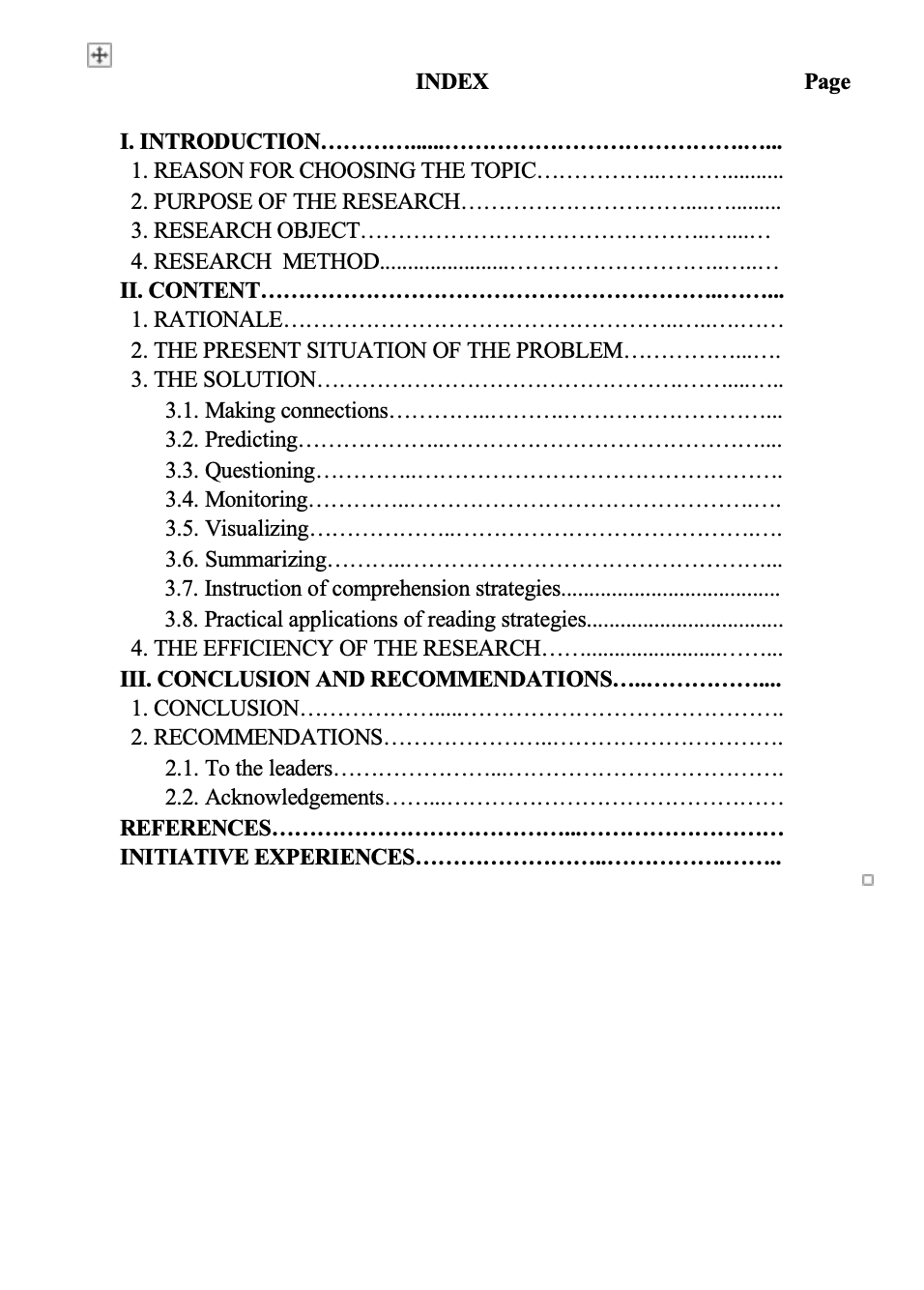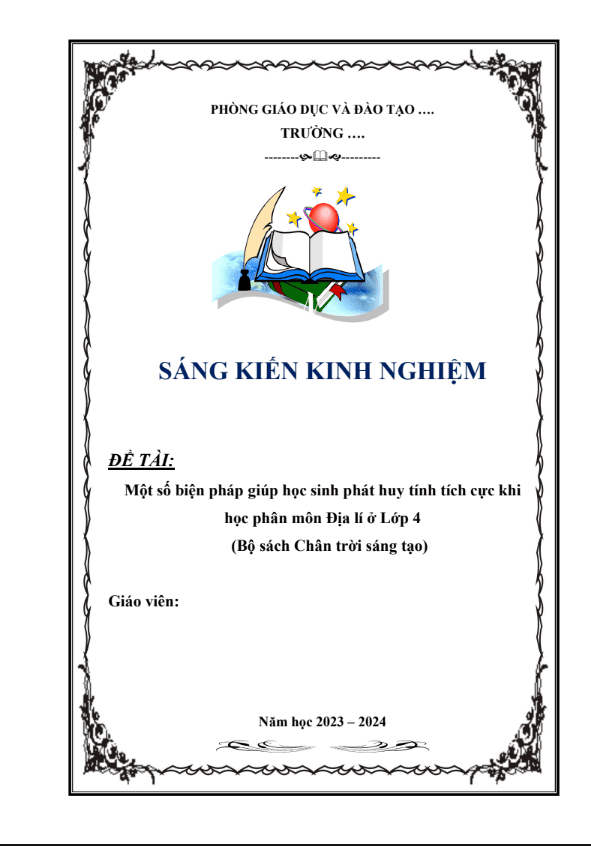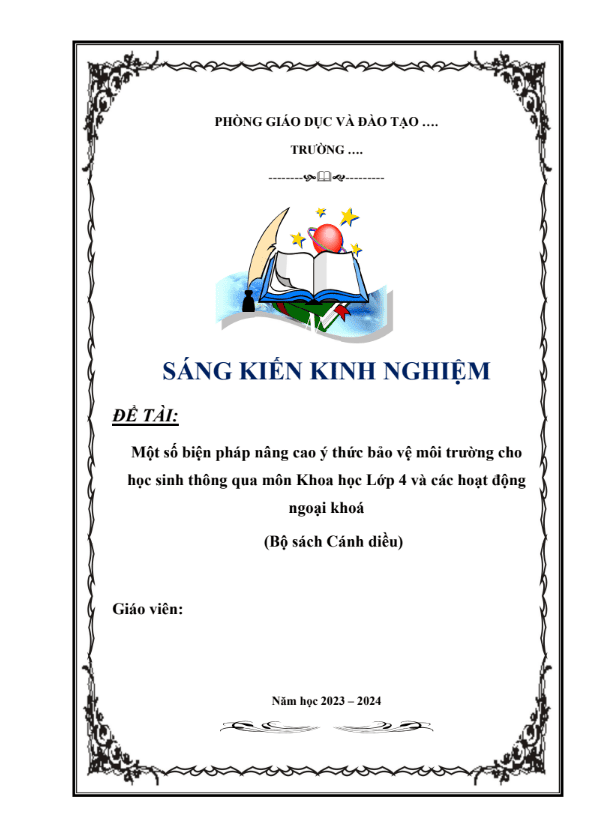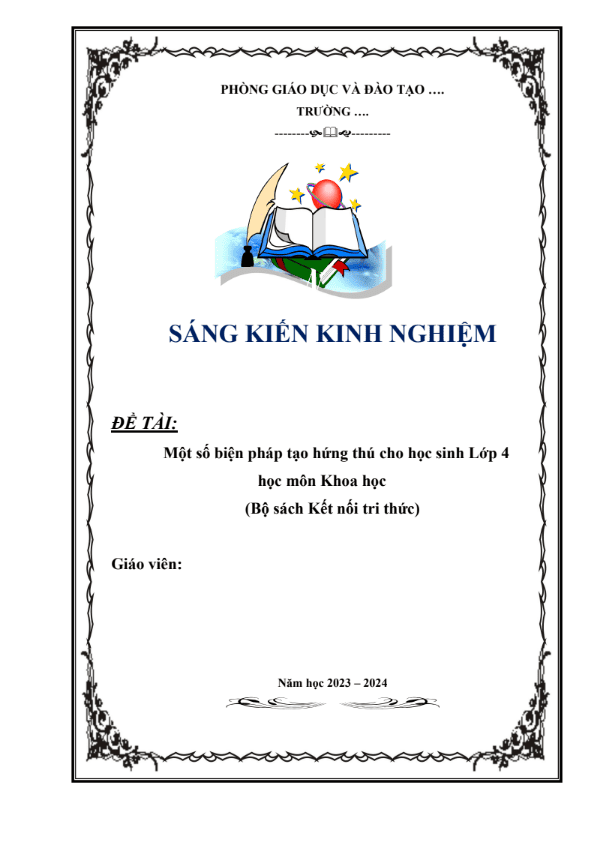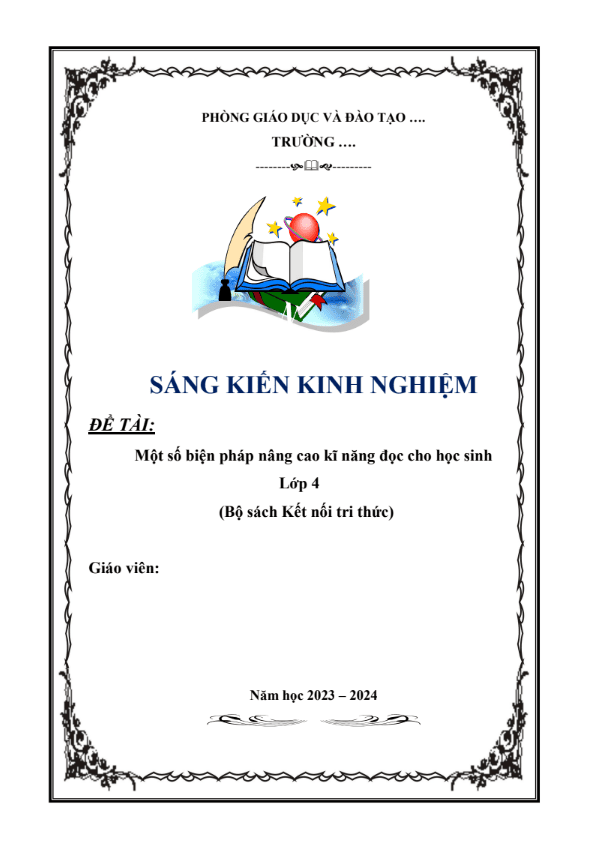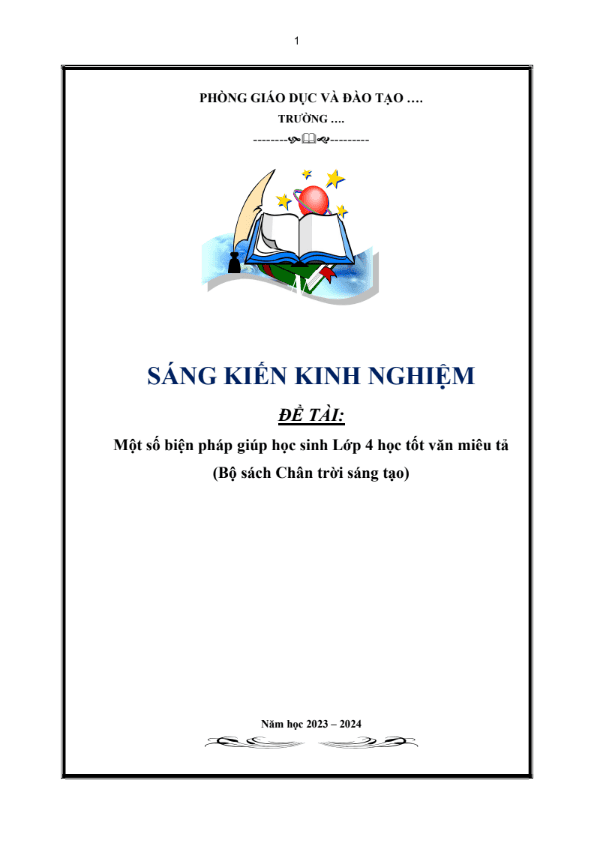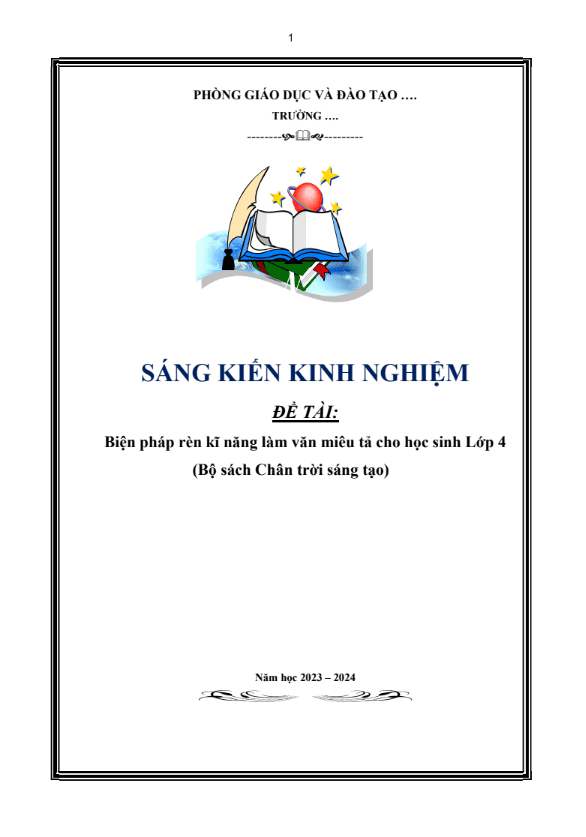SKKN Improve the quality of teaching reading English for grade 5 students
- Mã tài liệu: BM5100 Copy
| Môn: | Tiếng Anh |
| Lớp: | 5 |
| Bộ sách: | |
| Lượt xem: | 147 |
| Lượt tải: | 7 |
| Số trang: | 20 |
| Tác giả: | Nguyễn Thị Hồng Huyền |
| Trình độ chuyên môn: | Cử nhân đại học |
| Đơn vị công tác: | Trường Tiểu học Nguyễn Văn Huyên |
| Năm viết: | 2019-2020 |
| Số trang: | 20 |
| Tác giả: | Nguyễn Thị Hồng Huyền |
| Trình độ chuyên môn: | Cử nhân đại học |
| Đơn vị công tác: | Trường Tiểu học Nguyễn Văn Huyên |
| Năm viết: | 2019-2020 |
Sáng kiến kinh nghiệm “SKKN Improve the quality of teaching reading English for grade 5 students” triển khai các biện pháp như sau:
3.1. Making connections
3.2. Predicting
3.3. Questioning
3.4. Monitoring
3.5. Visualizing
3.6. Summarizing
3.7. Instruction of comprehension strategies
3.8. Practical applications of reading strategies
Mô tả sản phẩm
- INTRODUCTION
- REASON FOR CHOOSING THE TOPIC
Learning to read with understanding is the most important achievement in young student’s life. Unfortunately, many students are unable to comprehend texts even though they can decode them fluently. Consequently, teachers, researchers, and older educators have begun focusing on early comprehension instruction. This research addresses the role of metacognition in teaching comprehension to primary students. I begin with a short discussion of some of the basic concepts relevant to the study of comprehension and comprehension instruction. For readers in the middle years of school (Grades 5 – 8), any difficulties they experience may be intensified as reading changes from a learning outcome to a learning tool – that is, as the focus shifts from ‘learning to read’ to ‘reading to learn’ (Allington & Johnston 2002; cited in Nelson & Manset-Williamson, 2006, p.214).
The goal of constructing meanings or comprehension lies at the heart of reading. Consistent with the active and strategic notions of reading, reading comprehension is a complex and multifaceted ability that involves the reader’s orchestration of a number of skills and strategies when thoughtfully and critically interacting with written text. The knowledge, experiences and purpose of the reader, the content and features of the text, and the situation or context of reading influence reading comprehension. Specifically, reading comprehension is both the process and product of the ideas represented in the text linked to the reader’s prior knowledge and experiences and the mental representation in memory of the text (Kintsch, 1998)
The RAND Study Reading Group defined reading comprehension as the extraction and construction of information through the involvement and interaction with a text (RAND Study Reading Group, 2002). Successful comprehension involves sifting though a text to identity its main point and often going beyond that to critically evaluate or apply what has been understood. It consists of many components, such as identifying words meaning, processing sentences, linking idea across sentences, and inferencing. These components can be analyzed into myriad subcomponents and subprocesses, theories of comprehension (Graesser, 2007) do just that.
After exploring and accumulating the experiences from colleagues, I have some experiences in teaching reading comprehension and achieved quite effective results. The students are more interested in learning English and more confident in doing their reading exercises. This improves that my methods are right. With the passion and the love for teaching English, I have studied and developed the research: “ Improve the quality of teaching reading English for grade 5 students”
- PURPOSE OF THE RESEARCH.
– The research applies the methods of teaching reading comprehension to involve students in learning English well.
– Creating the language circumstance to communicate in English and promote students to actively participate in communicative activities; offering some solutions and methods for teaching reading comprehension.
– Exchanging and sharing some experiences in teaching reading comprehension for primary student.
- RESEARCH OBJECT
– Systematizing some theoretical issues about the procedures and activities in teaching reading comprehension in English Primary program according to the communicative approach.
– Exploring the present situation of teaching reading comprehension at Primary School and suggesting some techniques in teaching reading comprehension to develop reading skill for primary students, helping them be more confident to communicate in English.
– Research Object: “Improve the quality of teaching reading English for grade 5 students”
The respondents of the research: With this research I focused on students of grade 5.
- RESEARCH METHOD
– Method of survey investigation school year ……….
- CONTENT
1 . RATIONALE
When learners comprehend, they interpret, integrate, critique, infer, analyze, connect and evaluate ideas in texts. They negotiate multiple meanings not only in their heads but in the minds of others. When comprehending, learners strive to process text beyond word-level to get to the big picture. When comprehension is successful, learners are left with a sense of satisfaction from having understood the meaning of a text. Comprehension takes the learner to a new level of active understanding and insight. It enhances language and vocabulary knowledge. Good learners use a variety of comprehension strategies simultaneously and, according to Pressley (2002), they know how to deliberately apply specific strategies to aid their comprehension, particularly with regard to challenging texts/information.
A reader can read a variety of materials with ease and interest, can read for varying purposes, and can read with comprehension even when the material is neither easy to understand nor intrinsically interesting … Proficient readers … are capable of acquiring new knowledge and understanding new concepts, are capable of applying textual information appropriately and are capable of being engaged in the reading process and reflecting on what is being read. (p. xiii, RAND Report, commissioned by the US Department of Education).
The National Reading Panel (2000) emphasized the fact that comprehension is an active process between the reader and a text, a process that is both ‘intentional and thoughtful’.
There are many ways that students demonstrate their understandings of texts. They locate and recall information, draw on the knowledge of text structures and text organizers, write short reflective responses, complete multiple choice questions, think deeply and express ideas verbally, complete descriptions, recognize causal relationships, make logical connections, interpret graphics and images and identify multiple points of view and specific details.
It has been found that less able comprehenders usually focus more on word accuracy rather than comprehension monitoring and generally have weak metacognition skills (Cain and Oakhill, 1999; Nation et al., 2005). Students with poor comprehension generally are poor at making inferences and integrating text information, according to Nation et al., (2005). They tend to read superficially, are less likely to participate in constructive processes and are unsure of when to apply their prior knowledge during reading (Cain and Oakhill, 1999). Research has shown that there are sources of comprehension problems that are independent of decoding (Williams, 2005). Researchers have also identified students who cannot comprehend text effectively in spite of successful decoding (Caccamise & Snyder, 2005; Duke, Pressley & Hilden, 2004).
Learners who struggle with comprehension possess inefficient strategies and use them inflexibly. They are usually unaware of what good comprehenders do and need to be shown how and when to apply a small repertoire of comprehension strategies. Providing students with explicit instruction in comprehension strategies can be an effective way to help them overcome difficulties in understanding texts (Graham & Bellert, 2004). The more explicit the comprehension strategy and self-regulatory instruction, the higher the likelihood that the learner will make significant gains in comprehension (Manset-Williamson & Nelson, 2005). As learners become more competent and confident of their comprehension, the less support they require from the teacher (Duke & Pearson, 2002).
Research indicates that we build comprehension through the teaching of comprehension strategies and environments that support an understanding of text. It is important for educators and parents to teach children active strategies and skills to help them become active, purposeful readers. Teaching reading comprehension is an active process of constructing meaning, not skill application. The act of constructing meaning is:
– Interactive – It involves not just the reader, but the text and the context in which reading takes place.
– Strategic – Readers have purposes for their reading and use a variety of strategies as they construct meaning.
– Adaptable – Readers change the strategies they use as they read different kinds of text or as they read for different purposes.
* What Do Good Readers Do?
– Before reading, good readers tend to set goals for their reading.
– During reading, good readers read words accurately and quickly, while dealing with meanings of words.
– Good readers are selective as they read.
– Good readers use their background knowledge (schema) to create mental images, ask questions, and make inferences.
– Good readers monitor their comprehension as they read.
- THE PRESENT SITUATION OF THE PROBLEM
For many years, teaching reading comprehension was based on a concept of reading as the application of a set of isolated skills such as identifying words, finding main ideas, identifying cause and effect relationships, comparing and contrasting, and sequencing. Teaching reading comprehension was viewed as a mastery of these skills. Comprehension instruction followed what the study called mentioning, practicing, and assessing procedure where teachers mentioned a specific skill that students were to apply, had students practice the skill by completing workbook pages, then assessed them to find out if they could use the skill correctly. Instruction did little to help students learn how or when to use the skills, nor was is ever established that this particular set of skills enabled comprehension.
A significant base of research, developed over many years, is available to inform educators about effective approaches to teaching children to read. However, research on applying the methods of teaching pronunciation for primary students is in its infancy. This reflects the fact that many teachers in Vietnam are faced with the challenge of teaching children to listen and speak in English when the students have a heritage language that is not English and they are not yet proficient in English. Making this a more critical issue, several researches suggest that teachers are not receiving adequate professional development in effective strategies to teach reading comprehension for students. In order to make best use of the information presented in this research, many teachers might want to consider the following set of questions together in preparation for making decisions about teaching reading comprehension for primary students.
Analysis of my school’s performance in teaching and learning pronunciation in recent years showed that our average score in reading comprehension had been consistently below that of like other schools in Thanh Hoa City. It was a situation that was of concern and motivated a thorough examination of the school’s approach to the teaching of reading comprehension.
Our school is a public primary school in Thanh Hoa City. It is a large school with around ……. students, ranging from 6 to 10 years old. There are three to four classes in most year levels, meaning that collaboration among teachers is extremely important to ensure consistency in learning programs. After several years of teaching the book Tieng Anh 3,4,5, I found that most of the students do not like the reading comprehension exercises . They only focused on grammar and vocabulary and did not like to learn pronunciation during the lesson.
* The quality survey and students’ classification:
Based on the present situation of students in class 5A3 the level of all students is acquired after a few weeks of the school year with the methods of teaching reading comprehension. I had 40 minutes to test students in class 5A3 to survey and classify the students. The following chart will show the result:
| Class | Number
of students |
Excellent
(A) |
Good
(B) |
Fair
(C) |
Poor
(D) |
Fail
(F) |
| 5A3 | 39 | 0 | 12 = 30,77% | 18 = 46,15% | 5= 12,82% | 4 = 10,26% |
According to the survey result, I have classified the students and immediately applied the methods and experiences which I accumulated over the years to improve the teaching and learning quality.
- THE SOLUTION
According to the present situation in English classes at my school. Doing reading comprehension exercises is so difficult for all grades from 3 to 5, especially in grade 5. To improve this situation, I would like to present some techniques for teaching reading comprehension and elicit the strategies of teaching reading comprehension for primary students which I have researched and applied quite successfully at my school.
This research will attempt to address the common and serious reading errors that Vietnamese students produce. Activities related to the correction of these errors are designed to meet students’ different learning styles, namely auditory, visual, tactile, and kinesthetic learning. As for the research’s title, the “learner-centered” classroom, we take the term from a broader perspective, meaning that it is a class where students can feel, experience, and monitor their own learning of reading comprehension. The research will cover six comprehension strategies: Making connections, Predicting, Questioning, Monitoring, Visualizing, Summarizing with the expectation that it will provide the audience with comprehensive insight into ways of teaching reading comprehension. The presentation is by no means comprehensive; rather it is an opportunity for sharing what we know about new perspectives in reading comprehension instruction.
3.1. Making connections: Learners make personal connections from the text with:
– something in their own life (text to self)
– another text (text to text)
– something occurring in the world (text to world).
* Example questions/statements:
– This story reminds me of a holiday to my grandfather’s farm.
– This character has the same problem that I read/saw/heard in another text.
– I saw a program on television that presented things described in this text.
– Does this remind me/you of something?
– Has something like this ever happened to me/you?
* Example teaching idea
– Book and me: Students create two columns with headings Book/Me.
– Prior to and during reading students add details about the connections between the book and their lives.
TÀI LIỆU LIÊN QUAN
- 0
- 155
- 1
- [product_views]
- 6
- 163
- 2
- [product_views]
- 8
- 188
- 3
- [product_views]
- 3
- 125
- 4
- [product_views]
- 5
- 118
- 5
- [product_views]
- 8
- 110
- 6
- [product_views]
- 7
- 116
- 7
- [product_views]
- 0
- 188
- 8
- [product_views]
- 5
- 192
- 9
- [product_views]
- 1
- 187
- 10
- [product_views]

